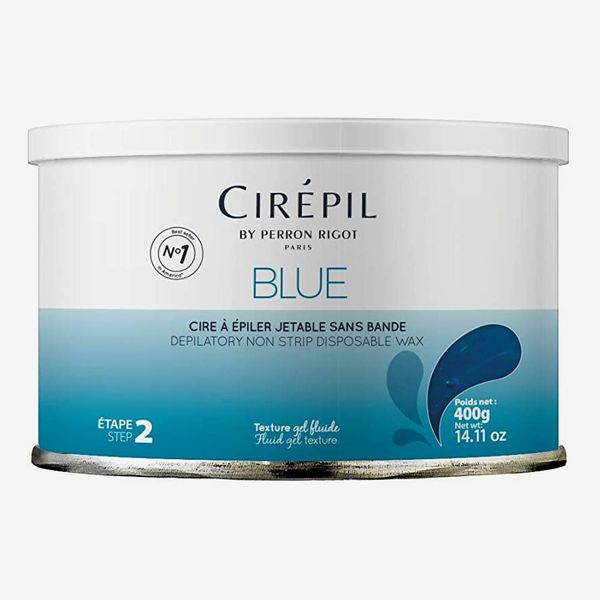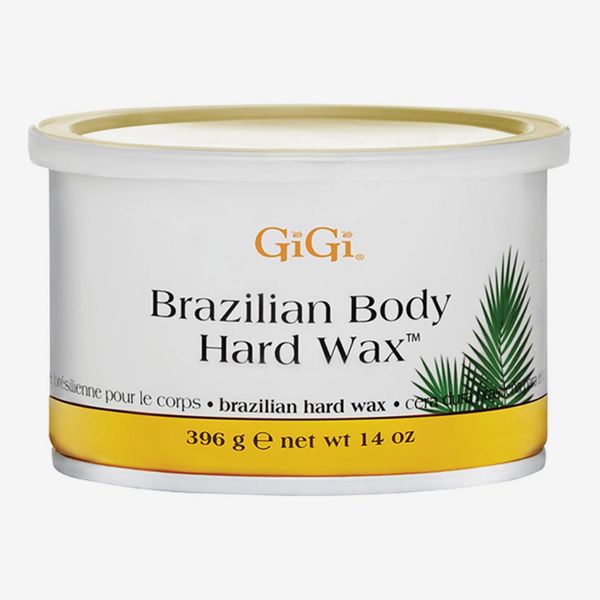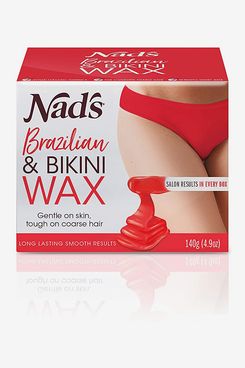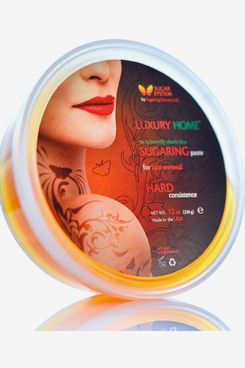
Perhaps out of necessity, the last few months have empowered lots of people to try things they never thought they would — especially in the personal grooming arena. Many of us have cut our own hair, shaped our own brows, and — believe it or not — given ourselves Brazilian waxes. We’ve written a lot about at-home waxing, and even covered bikini waxing, but going full Brazilian, which involves removing all the hair from the pubic area and beyond, is a whole new level of DIY. Not only is this procedure quite painful, but it’s also not particularly safe. In fact, while many estheticians feel totally fine endorsing at-home waxing for other parts of the body, we want to be clear that the professional recommendation is not to do your own Brazilian.
“We don’t recommend you do your own Brazilian,” says Alix Shapiro, co-host of the True Beauty Brooklyn Podcast and esthetician at True Beauty Brooklyn. The skin in the pubic area is very thin and sensitive, and someone without experience runs the risk of burning themselves. “But we know people are going to do this regardless, because of the current situation,” Shapiro adds, “so if you’re going to do this, we should at least guide you and give you the best tips that we can.”
With a Brazilian, the recommendation is always to go with a hard wax, never strip waxing. “The strip wax is very sticky and tacky,” says Elizabeth Taylor, owner of True Beauty Brooklyn. “It’s very messy to work with, even when you’re trained — so if you’re not trained, you’re gonna get that shit everywhere.” Taylor, who has waxed herself twice, also explains that the soft wax used with strip waxing sticks to your hair and skin, meaning when you rip it off, you’ll feel the sting of the hair follicle being removed and the pull of your skin. Hard wax, Taylor says, really just grips the hair, not the your skin.
But it’s not all about the wax. With such a sensitive area, it’s important to prep the skin and take care of it afterward. We talked to Shapiro, Taylor, and six other at-home waxers about all the products they use to (literally) pull this off at home.
Pre-Wax Prep
Cleansers and exfoliants
Everyone we spoke to recommends starting this process clean and fresh out of the shower, and Shapiro and Taylor note that it’s important to further prep the pubic skin. Some of the waxing kits we’ll get into below come with a pre-wax spray but “you need to clean the skin with an antiseptic,” Taylor says. “You can use alcohol wipes or you can use witch hazel to get dirt, oil, or bacteria out.” Witch hazel will not only clean the skin, and it also happens to be good for preventing ingrown hairs, so this can be used again after you’re done waxing.
Lauren Napier, the founder of Lauren Napier Beauty, has waxed herself twice during the quarantine and found that exfoliating with the Luv Scrub pre-wax was a great way to prep and avoid ingrown hairs. She likes the mesh body exfoliator because “it’s 18 bucks, it lasts you all year long, it doesn’t collect bacteria, and it just helps to just keep your skin really smooth and sexy.”
Napier pairs the exfoliator tool with Fur Silk Scrub, which “helps to reduce any ingrown hairs and kind of bring them to the surface.”
Oils
Napier, Shapiro, and Taylor all like this Fur Oil for both pre and post wax. Before the wax, Taylor says you’ll want to prep your skin with an oil “so that the wax just picks up the hair and doesn’t pick up your skin.” Plus, cleansing with witch hazel or alcohol will dry out your skin, and the oil helps keep it moist. Taylor says if you don’t put oil — whether it’s one of these fancier options or good ol’ jojoba oil — in between the skin and the wax, the wax might adhere to your skin and you run the risk of pulling up the skin when you remove the wax.
This oil is another favorite of Taylor and Shapiro’s. They like how lightweight it is, because you don’t want the skin to be overly saturated pre-wax. And because it’s a hybrid between an oil and a serum, it’s especially nourishing. “It features squalane, as well as avocado and rosehip seed oil, plus it has water in it, which is where the hybrid element comes in,” Karen Young, the company founder, explains. It’s also fragrance free, so there’s nothing in it to irritate the skin, which is so important with such a sensitive area.
[Editor’s Note: This item is currently out of stock, but you can sign up to receive a notification for when it’s available.]
Dry brush
Prior to her own hair removal, Young likes to dry brush. “It helps us to pick the hair up away from the skin as it’s starting to grow back, and that way they’re less likely to fall back into the skin and get trapped,” she says. “So if you dry brushed before waxing, for example, it will help the wax to grab on to more of the hair, because the hair will sort of be standing on edge a little bit and you should achieve a closer wax that way.”
Powder
Applying powder to the waxing area is technically optional, but almost everyone we asked said this was crucial to the process. “I think that you should have plenty of baby powder available,” says Rebekah Austin. She’s the owner of The Saditty Kitty, a waxing and sugaring salon in Buffalo, New York, who has gained over 100,000 followers on TikTok sharing her waxing advice. The wax won’t harden if there’s too much moisture, so if it’s a hot day or you’re sweating due to nerves, applying baby powder directly to the skin will absorb some of the moisture. Briana Pollard is a regular at European Wax Center, where she learned this technique, and she applied it to her own at-home Brazilians. She forgot to use it the first time around and had a much better experience round two. “I strongly recommend using the baby powder,” she says. If you want an all-natural powder, one without talc, Taylor and Shapiro recommend arrowroot powder.
A small mirror
Everyone we spoke to said they do their Brazilians in front of a mirror. If you have a full length mirror you can position yourself in front of, that’s great. If not, blogger Lydia Dinga (who has a step by step waxing video on her YouTube channel that’s been viewed hundreds of thousands of times) recommends getting a handheld mirror — or a “coochie mirror,” as she calls it. She says it should be a small handheld mirror that’s lightweight enough to hold with one hand. That way, “you can see the lady bits and you can see exactly where you’re waxing,” she explains.
Wax
While the wax you choose is important, your technique is even more so. The main concern with an at-home Brazilian wax is accidentally burning yourself, so it’s crucial to pay attention when heating the wax. Dinga, who is 27 and has been waxing herself since she was a teen, had an injury in her early years when she accidentally warmed up her wax in the microwave for 20 minutes instead of two. “It spilled all over my right hand, and I had to call the ambulance,” she says. “It was a first-degree burn. You could see the bone.” But that didn’t stop her from trying again, and if you, like Dinga, still feel emboldened to give it a go, the best waxes, wax warmers, and applicators ahead.
Taylor says there are only two gold standard brands of wax, and Cirepil is one of them. “That’s what we use exclusively,” she says. “It’s a hard wax, and it comes in little beads. It’s a really high quality wax from France.” She adds that any cheap waxing pot will do, but likes this one because it has different settings, not just an off and on switch, so you can better control the temperature, which is key. You can either turn it all the way up for the wax beads to melt and wait for it to cool, or set it to medium and wait for it to melt slowly. You’ll know it’s ready when the consistency is like peanut butter, Shapiro says. “If it’s too watery, it’s way too hot,” she advises. “You want it to easily stick to the stick.”
She recommends jumbo popsicle sticks, which will either come with your wax kit or can be purchased separately. You can use them to stir the wax, as well as apply it. The key to proper application is slapping on a thick-enough layer of wax, about the width of a nickel, “and you want to lay the wax in the same direction of hair growth because you’re going to pull it in the opposite direction,” Taylor says. “You’re going to hold the skin of your thigh taught with one hand, whatever is your less dominant hand is, and then you’re going to take your dominant hand and pull it in the opposite direction.” She says you’ll know the wax is ready to remove when it feels like silicone.
If you’re nervous, start on the outside and work your way in. “That’s also the test of knowing that you can get through the rest,” Taylor says. “If you do your thigh and you are screaming at the top of your lungs, maybe don’t keep going.” To help with the pain, Hannah Asmil, a doula who has not waxed herself but has been trusted by a few friends to do theirs, advises to immediately apply pressure with your hand after you remove the wax strip. She says it “helps with the pain so much.”
Austin agrees that the Cirepil wax is good (though she prefers the lavender one). However, in this TikTok she explains it doesn’t work well on coarse hair. As an alternative, she recommends this, which is a thicker wax that can pick up a lot of hair. Another bonus: It’s easy to find at a local beauty supply store.
After some Amazon searches, Pollard landed on this waxing kit. She says it’s truly the whole package: a warmer, wax beads, applicators, plus pre-waxing and post-waxing spray. “It came with everything I needed for a good deal.” In addition to showering and using this kit’s pre-wax spray, Pollard’s prep included a couple of shots of alcohol for nerves. Unfortunately she said it still hurt — she had her last professional wax in March and didn’t try it at-home until May — but there were things that helped the process along. The wax was initially too hot, she says, plus she made the mistake of waxing standing up the first time around; the second time she sat with her legs in the butterfly position, and moved around with the help of a mirror. “I’m laying on the floor and trying to contort my body in weird angles to make my skin stretch more,” she said. “That did help. It still hurt, but it helped and I was getting definitely more hair off as I did it that way.”
This wax kit comes with different waxes for different parts of the body and for different hair textures, which Napier appreciated. She used one for coarse hair and had one of the more pleasant experiences of everyone we talked to. “I was able to pull using both hands and was kind of in like a Cirque du Soleil acrobatic position in the bathroom,” she says. “But I did it, I managed, and it was painless and fast — faster than I anticipated.” Another piece of advice from Napier: “Make sure you psych yourself up, because you got to be ready to pull through the pain, literally and figuratively.”
The least painful but most challenging part of the process was the back strip for Napier, but she managed. After all, it takes just one misstep, and “your butts are glued together with wax,” she warns. She ended up “bent over staring into the mirror at my naked vagina and butt crack staring at myself upside down” to do the back strip.
This kit only comes with two applicator sticks, so you will need to buy extras, but this is the wax Dinga has trusted for years. She’s such a pro at waxing, “I should probably put it on my CV to be honest,” she says. She likes this wax more than others because the gel consistency goes on smooth “and when it comes to taking it off, it comes off as one big gel piece, and doesn’t break off into sections,” she says. It’s the cheapest wax on this list and only needs to be heated up in the microwave, so you also save money on a wax pot. Still, Dinga warns, “Every time I talk about waxing, I say that it saves money and that it is great, but you can also really hurt yourself so be careful and pay attention especially to the guidelines on the back of the wax packets, because they know that things can go very wrong,” she says.
A couple people we talked to strayed from the recommended hard wax and tried sugaring. Austin explains there’s two types of sugaring, a hard sugar and a soft sugar, just like with waxing. “How the sugar is going to go on the body is dependent on whoever has made the sugar,” she says. “If it’s cooked longer, it’s going to come out harder, and if you cook it less, it’s gonna come out soft.” She likes it because it’s natural and gentle on the skin as opposed to waxes. “All it is is a mixture of sugar, water, and lemon juice,” she adds. “It’s hypoallergenic and it’s probably going to be the most gentle on your skin.” Unlike with hard wax, Austin says with hard sugaring you want to apply it in the opposite direction that the hair is growing and remove it in the direction the hair is growing.
Ciara Imani May, the founder of Rebundle, a recycle program for synthetic hair, decided to try sugaring after a friend recommended it to her. Like hard wax, sugaring also doesn’t need a cloth strip compared to strip waxing, and you don’t have to heat it up as hot. May said she stuck this in the microwave for 15 seconds, and then applied it with her hand. “What I really liked about it is that it’s biodegradable. I just threw it in the toilet when I was done,” she says. It also was a very fast process. “The first time it took me 30 minutes, the second time it took 15,” she says. The appeal of waxing in general is that hair grows back finer, and May thinks that’s especially true for sugaring. “I felt like between that first wax and the second one, the hairs were much finer. Even right now, they’re still super fine,” she says.
Gianna, a physical therapist who asked that we only use her first name, also went with a sugaring kit for her first at-home wax after seeing a YouTuber’s success with it. Compared with hard wax, she says, “I liked the sugaring better because I felt like I could go over the same spot multiple times if I needed to and it wasn’t going to get irritated.” This is, again, because sugaring wax doesn’t need to be that hot. In fact, with this kit, Gianna says the recommendation for coarser hair is for the paste to be a more gooey consistency, so she only heated it up for 30 seconds. This kit comes with wax and square-style applicators that you apply and remove the wax with. Gianna says the wax doesn’t require any drying time either. You just apply it, with the applicator in the same direction as the hair growth, and pull back immediately, using the applicator, in the opposite direction. Overall, she felt she got just as close of a wax with sugaring as she does hard wax, and experienced the same amount of pain.
Contrary to the other pros we talked to, Austin isn’t completely opposed to soft wax, at least for part of the job. “Soft wax is generally pretty harsh on the skin, but it is user friendly,” she says. “You just put it on, and you put the strip on, and then you take it off.” For this reason, she says it would be easy for a beginner. Pro or not, though, she doesn’t think soft wax should be used when waxing the lower lip area because “most people’s lips have a lot of folds and creases and texture,” making it difficult to effectively apply. If you do decide to use a mix of hard and soft wax, this is Austin’s pick for the latter. She loves the chocolatey smell and says it’s pretty gentle as far as soft wax goes: “It’s hypoallergenic, so that’s why I like it. I’ve used a bunch of different ones, I just prefer the smell of it and think the texture is really nice.”
Post-Wax Care
So, you’re done with the wax — but you’re not done yet. A big part of a successful at-home wax is tending to the skin afterward. Taylor and Shapiro recommend using either of the pre-wax oils again, which will not only soothe the skin and hydrate it, but the oil will also help to remove any existing wax. After a few days, it’s time to exfoliate, Taylor says. “When you’re waxing, you are removing the hair from the follicle — but you’re also, by default, exfoliating your skin a little bit,” she explains. “Ingrown hairs start to come in when your hair and your skin are regenerating, but your skin regenerates faster than the hair follicles, so by the time the hair follicle reaches the surface it doesn’t have any place to go but back down. You want to be exfoliating so that everything is just on the same cycle.” Like Napier, she recommends the Fur Silk Scrub noted in the pre-wax section. With AHAs in it, the chemical exfoliant is “gonna be brightening, hydrating, and help with hyperpigmentation.” Beyond reapplying these products, some of the other waxers we talked to have a few more things they like to use.
Napier reapplies her Fur oil on the landing strip she leaves, but she also likes to replenish the area with this oil at night.
Everywhere else, Napier uses the Hanahana Beauty Lavender Vanilla Body Butter.
Austin likes using butters, as well, to lock in all the moisture. “I like the raw unrefined shea butter,” she says. “I like it melted down and sometimes I’ll even whip it up to make it even softer.”
Napier also has some hyperpigmentation in her bikini area, and has been using this vitamin C serum to combat it. “I’ve been using it to balance my skin in that area, because I thought we’d be outside right now at the beach,” she says. And this stuff works. “It’s really great. I’ve been using it for months now and it’s really evening out my skin.”
Pollard likes to use these two products from the European Wax Center, where she typically gets waxed. She says they slow down the hair growth and get rid of ingrown hairs.
Hopefully the wax pulled up everything, but even with professional waxes, sometimes there are some stragglers. Napier likes to use tweezers to get whatever “I didn’t see while I was bent over upside down in the mirror.”
The Best Razor Alternative
If all of this just seems a little too daunting, don’t worry. “Be kind to yourself,” Taylor says. “The reason that you’re doing this is for yourself, so that you’ll feel beautiful and sexy and comfortable.” If you don’t feel comfortable doing it, don’t do it, she advises. Taylor says that while she never recommends razors, she makes an exception for this one, because it’s so good. “I think it’s the next best thing to getting a wax, if waxing just isn’t for you,” she says.
[Editor’s note: This is currently sold out, but you can sign up for notifications for when it’s back in stock.]
The Strategist is designed to surface the most useful, expert recommendations for things to buy across the vast e-commerce landscape. Some of our latest conquests include the best acne treatments, rolling luggage, pillows for side sleepers, natural anxiety remedies, and bath towels. We update links when possible, but note that deals can expire and all prices are subject to change.

































